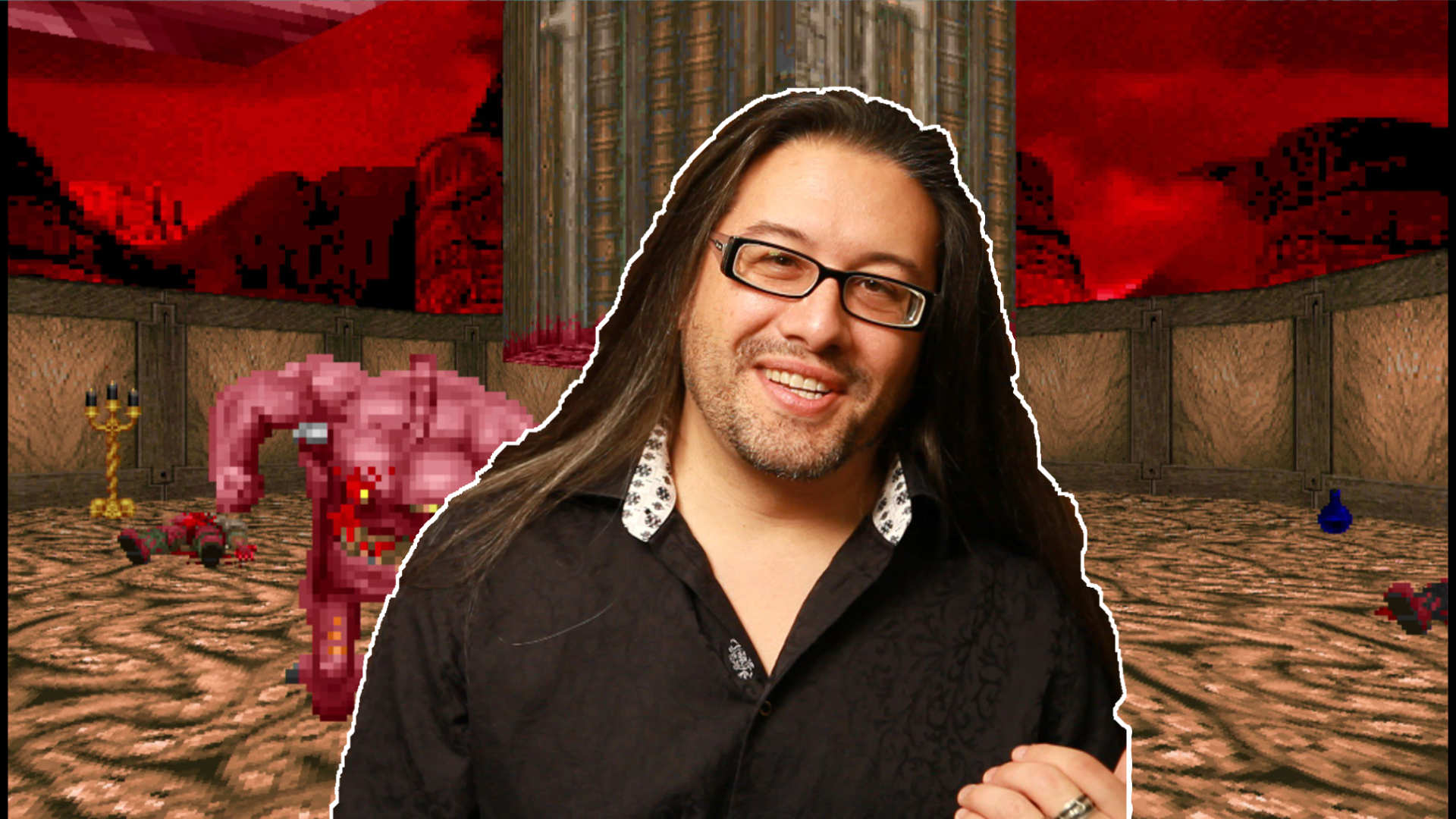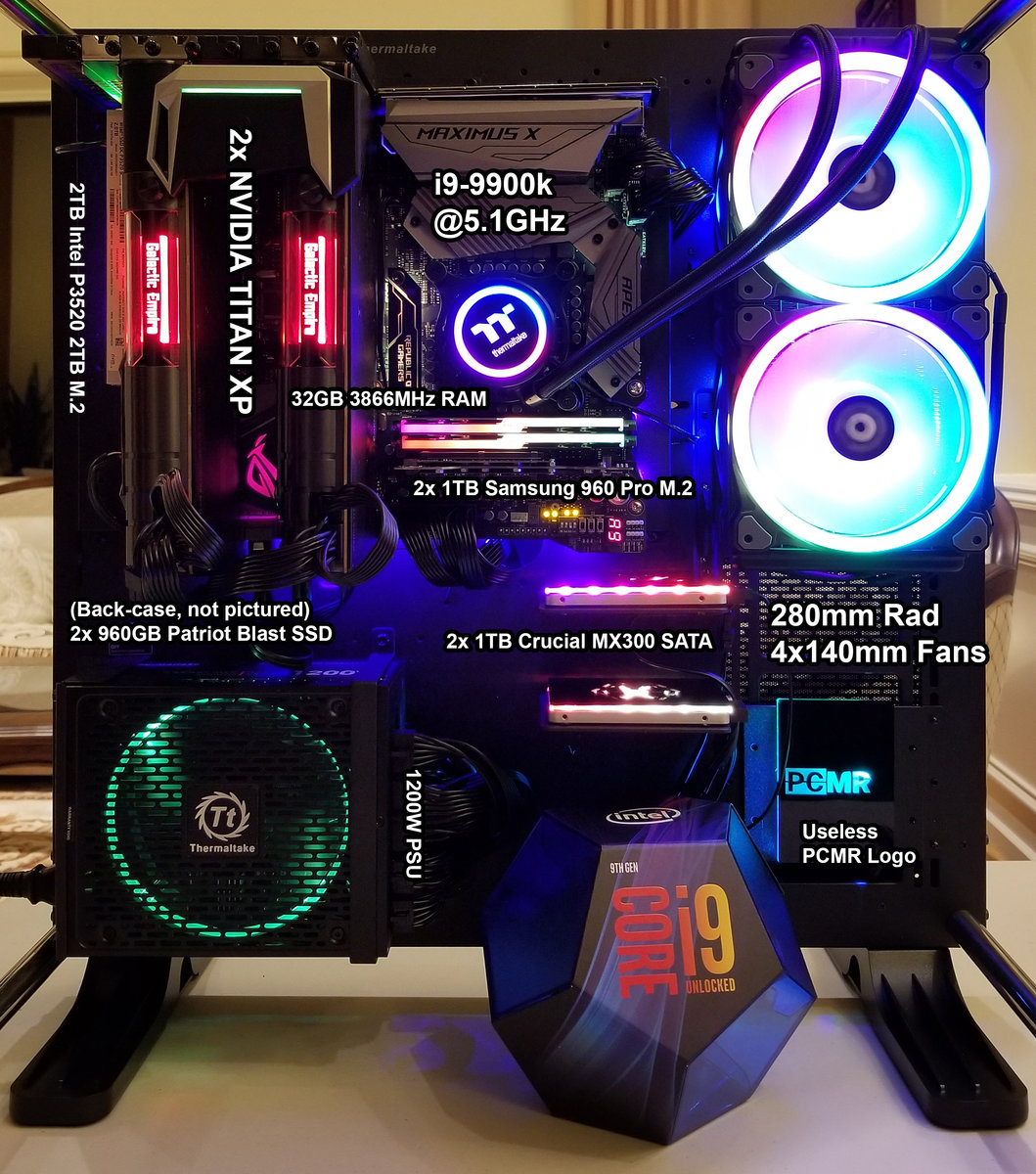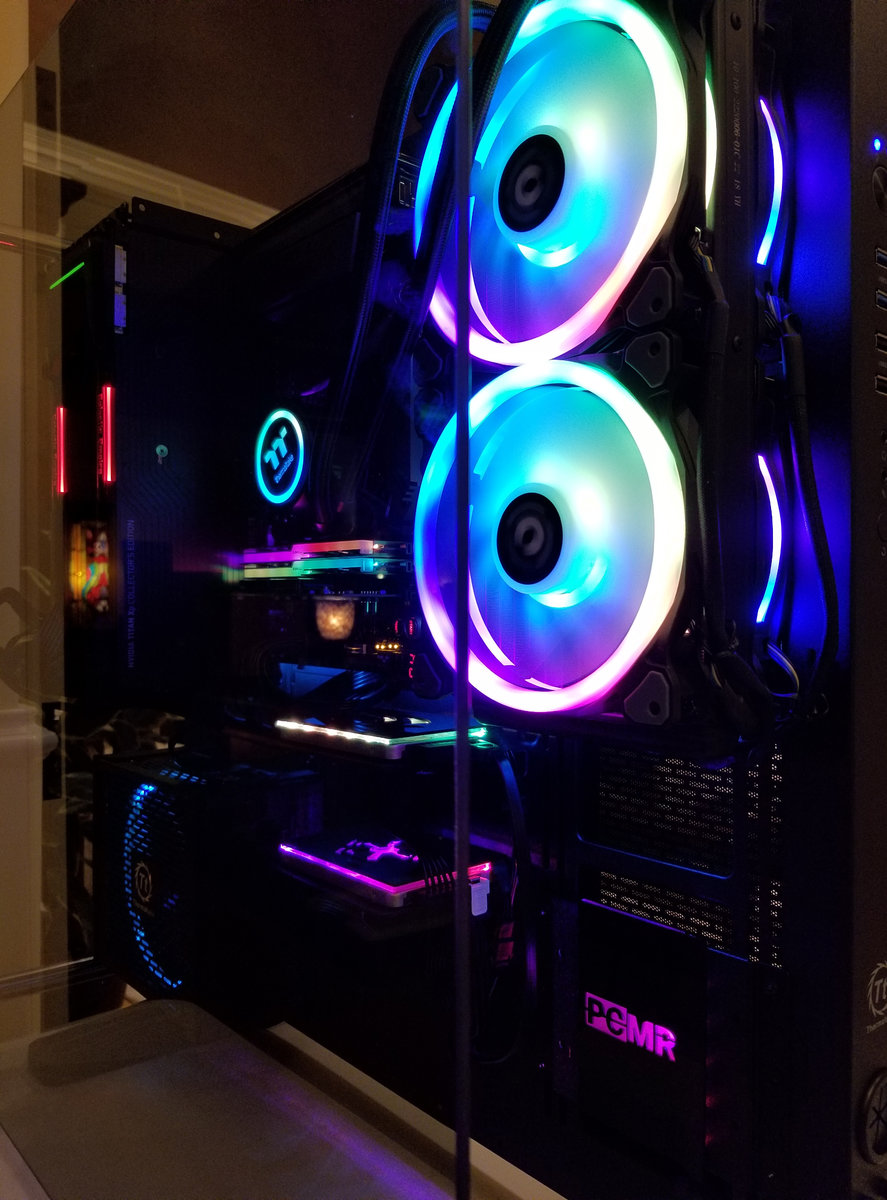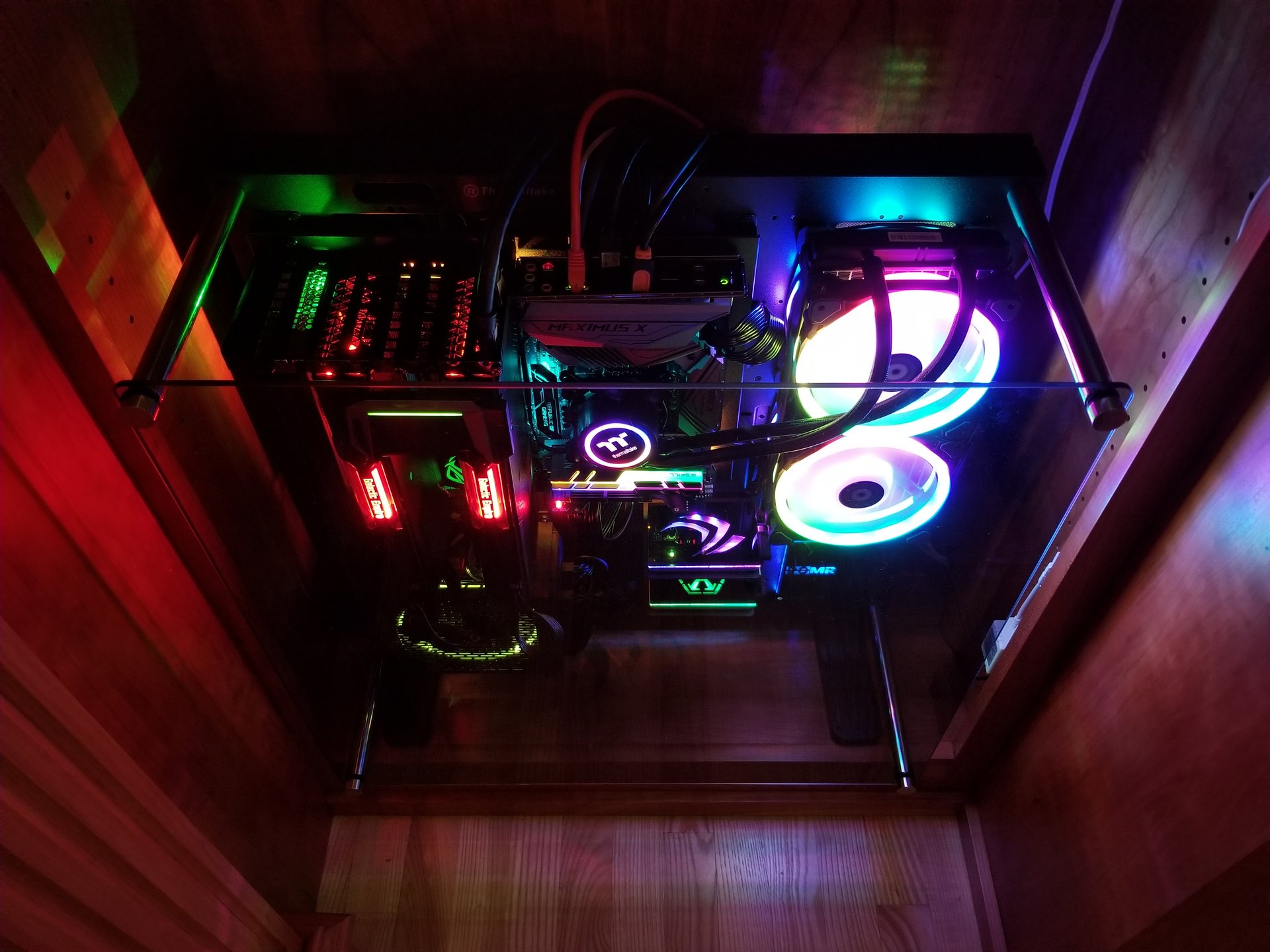-
Posts
1839 -
Joined
-
Last visited
-
Commemorating one decade of shame(lessness)

-

Reminds me of that time noob saibot and a couple others spammed the shit out of the Skulltag forums with (>o_o)> ... I sometimes get old events from ST and DW mixed up because they used to look practically identical:
Jeez, I forgot how much of a blatant rip-off it used to be!
-

Unlike those boring spammers, each and every one of my obscenities is lovingly handcrafted.
They don't make them like they used to ;)
-
-
Why hello there, drawn in by the 25th birthday? I mainly wanted to check if DV2 and KS2 got released, for old times sake, but frankly my expectations weren't high on that :P
-

ya I was notified. I'm still working on DV2's second edition. Lots of work to be done, once I get it to demo'able state, would you like to work with me on testing them like before?
-
Damn, it's been ages since I've played Doom so I doubt I'd be able to provide the expected quality of feedback. I'd have to check if I'm still able to play a map and feel satisfied with how I'm doing before I answer that. Thanks for the offer though.
-
-
Deus Vult II 2nd edition when???Good to have you back
-
My RAID1 array, designated to preserve some of my most irreplaceable data--including reports, photos, artworks, and Deus Vult II's assets--has shatted the bed for the last time.
A pair of WD Caviar Blacks of 640GB running at 7200RPM, it sat inside my main PC's since 2009.
It began two months ago with one of the drives intermittently "clicking" and losing data. Intel RST was able to rebuild data, but that same drive kept clicking... then as of two days ago, the entire array failed, attributable to the surviving drive unable to find an MBR.
Considering the nature of how spinning disks work, it's smart to not rely on them as exclusive backup, even in a closed redundancy system. A possibility negating this backup method is, if I get robbed... so much for RAID1.
Ever since the advent of cloud storage years ago, I practiced storing things in a combination of GMail, DropBox, GoogleDrive, and Skydrive, in those orders. Who stores all of their virtual eggs in one basket these days?
As Voldemort made good practice to back up himself with horcruxes, as Sauron made good practice to back himself up with The One Ring, I made good practice to store Deus Vult II's supporting assets in many places and persons. Should I die suddenly and the world most likely continue on without me, those people have been instructed to release the latest edition of whatever I shared them.
Now if I can remember all the songs I need to recover...- Show previous comments 9 more
-
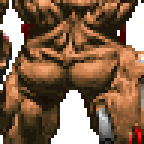 printz said:
printz said:I've had terrible experience with all computer optical disc drives
The drives themselves are to be considered disposable -even hi-end standalone CD players have a quite finite laser pickup life in the range of 2000 hours, burners have even less), and DO require periodic maintenance (cleaning the lens directly, not with a stupid "lens cleaning CD", and cleaning any contacts where flexy ribbon cables attach, those can go surprisingly bad).
The disks however, given high quality media and reasonable handling, can last a long, long time. The oldest CD-R I have is from 1994 (Golden TDK) and still read at full speed in all drives, showing how low the error rate is. For modern CD-Rs in cakes of 100 I have my doubts, though.
And, Doom Marine, a single BD-R disk would've saved at least your entire music collection ;-) -

I jumped on the blu ray bandwagon already. Things seem to be working well. I have a CD-R from 2002 I made that still reads. Keep your discs in a dark temperature controlled environment and use reputable brands and you'll be fine I think. The super important stuff finds its way onto multiple discs and multiple types of media for me (not to mention multiple locations.. Huy's choice of cloud is a good way ensure your data's safety if your possessions are stolen or your house burns down.)
-

Cloud storage is great in the sense of decentralizing data storage; your stuff is almost everywhere with an internet connection. The downside is, if you're not paying monthly fees, then capacity isn't that great.
I scraped up about 5GB from DropBox, 10GB from SkyDrive, 5GB from GoogleDrive. For me, there is enough space, but I do have to choose which folder to leave behind, because there's no way that Music Folder is hopping on the cloud bus without a ticket.
Cloud storage is resilient up to the point of thermonuclear warfare... in which case, it's back to burning things on disks and burying it underneath the backyard for the next civilization to decipher.
-
Being used to the high performance of my PC, I had a hard time adjusting to the Athlon XP's at work. Since it's not practical for me to take my hulking mass of computing destruction on the road, it was time get a laptop.

The Asus G55VW fits the bill. I got this laptop back in September on a labor day sale, so it was very cheap for its performance (especially without hard drives). Some notable things:
Size: Despite me specifically choosing a 15.6" screen for mobility considerations, the frame of the laptop itself is easily 17" form factor. The design team really didn't give a shit about form factor.
Build Quality: The chassis is heavy, the monitor housing is solid as a brick, there is little to no flex upon opening and closing the laptop. It should be noted that it's still made of plastic... nevertheless, still very solid in the way it's put together.
Design: The shell of the G55VW is streamlined and aesthetically pleasing, the keyboard platform is sloped towards the user, there is a resting space before the keyboard that is very comfortable to rest my wrist upon, and the keyboard itself is backlit, tactile, and the keys are adequately big.
Noise/Heat: Two large vents carry heat to the back of the chassis and away from the user, it's practically inaudible during web usage. The cooling system gets high marks for keeping the keyboard area free of warmth, even during long gaming sessions.
Performance: i7, GTX-660m, 16GB of RAM, and I stuffed two SSD's in there. What isn't there to like?
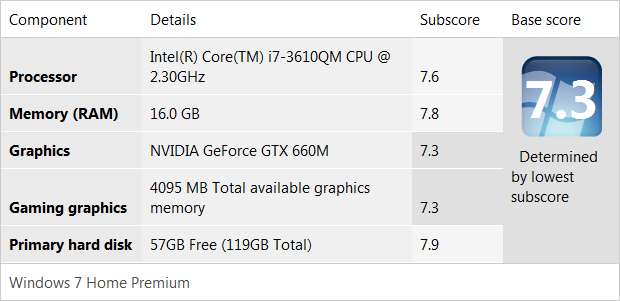
Aside from gaming performance, one of my favorite things about having good hardware is the snappiness of having things respond and open almost instantaneously, and that allows for a better user experience, which translates to less PC aggravation, and much more work done.
What takes about 5 minutes to load at my work's PC, is operated upon in a flash of an eye with my laptop, and for that, it's damn worth every penny.- Show previous comments 13 more
-

-

-
 GhostlyDeath said:
GhostlyDeath said:You must get a nice 10 minutes of battery life.
But hey, that system is way more powerful than an equivalently priced MacBook.This laptop can last about 3-4 hours surfing the web, depending on streaming content. I have a tablet PC for another level of mobility and battery life.
This is a mobile workstation PC that I can deploy near a power outlet and let loose all 8 threads. Even the most expensive Macbook Pro falls short of my workhorse.
printz said:Won't you run out of SSD space soon? What about heavy games or hell, any kind of software with gigs of data?
The laptop has two 128GB SSDs. One is strictly dedicated to the OS, the other for programs and few select games. I'm not one of those people who hogs like 100 gigs of movies and music. The two SSD's are more than enough for my needs.
-
It started about 6 months ago with Mike Reiner and I brainstorming about our next upgrade. We exchanged various ideas about power, acoustics, and maintenance, and it ended up in the both of us having almost identical system upgrades.
This PC upgrade is geared towards high-end competitive gaming and content creation, such as HD image and video editing. In addition to being powerful, I'd also like my PC to be cool, whisper-quiet, and nearly maintenance-free at reasonable cost for the performance.
It's easy to get carried away with sheer power, but there is the acoustic footprint and temperature requirements to consider. It's an NP-hard combinatorial optimization problem that I've looked at with six months of research.
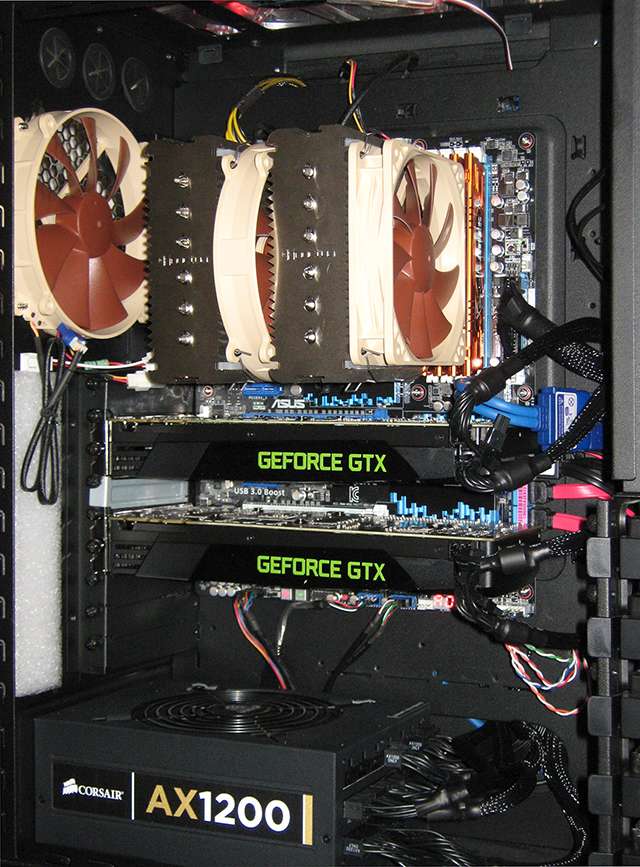
A 3770k fits the bill right off the bat. With a 77W TDP, it's powerful while maintaining a relatively small power footprint. The Noctua NH-D14's giant-size allows plenty of cooling headroom, which allows their already quiet fan to be voltage modulated down to 900 RPM. The 3770k runs at 4.2 GHz with dynamic voltage 0.9-1.2V.
I wasn't sure about the acoustic footprint of the two GTX 680's, but now that I have them for a week, they are barely audible (when idle) above the rest of the nearly-silent hardware and cool-running for a flagship card. They will allow me to max out many modern games at 120hz.
I didn't need anywhere near 1200W of power, the AX1200 was picked up on a $225 sale. It was too good for the price and a PSU is one component that I never, ever cheap out on. I've seen way too many instances of shoddily-made PSU's destroying entire systems. Note the 140mm fan, big fans pushes a lot of air but are dead quiet.
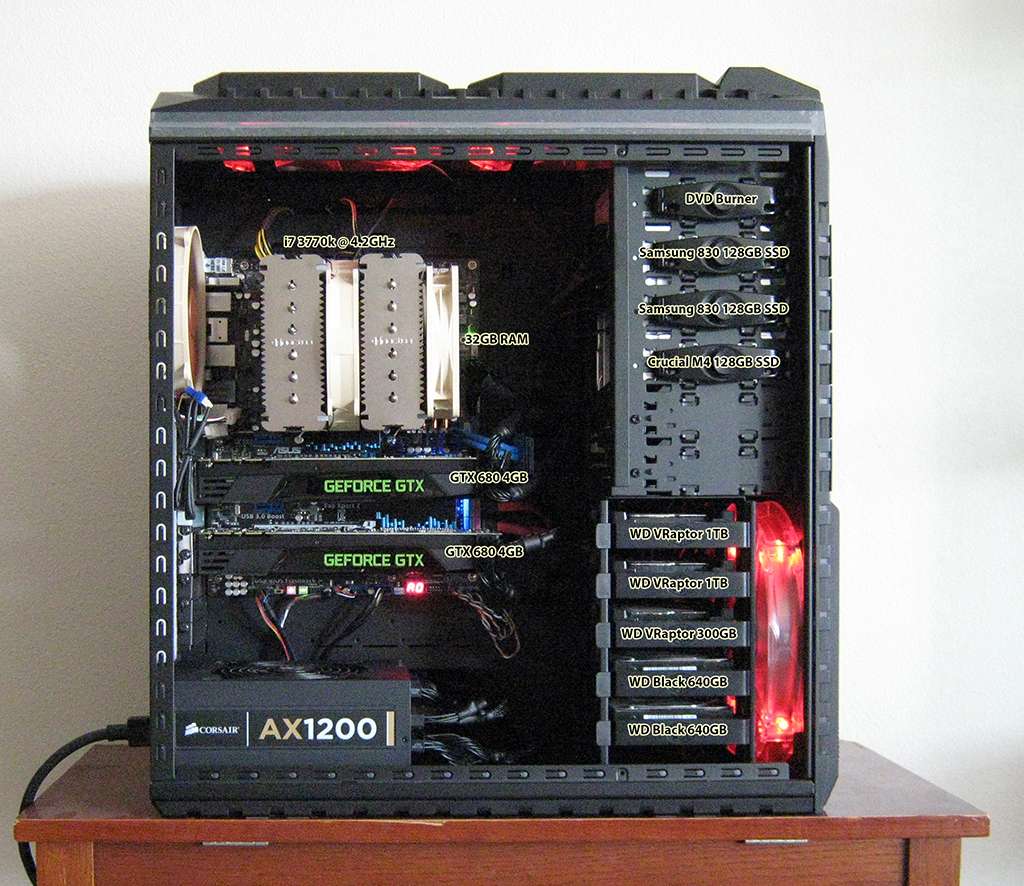
With this much hardware, a HAF-X just makes sense.
Let's talk about hard drives. I'm a fan of modularity of storage. Having different kinds of data across different drives reduces the frequency of interrupt, reduces the write/erase load on the SSD, and makes defragmenting the spinning drives a lot easier.
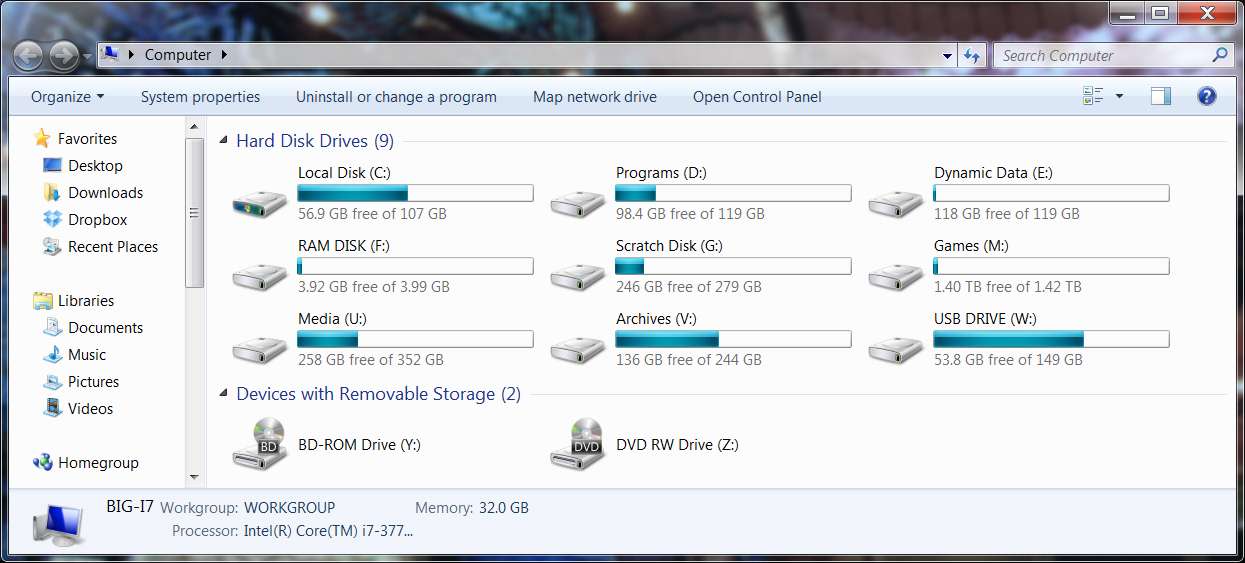
OS Drive C - Samsung 830 128GB SSD: OS and Drivers.
Programs Drive D - Samsung 830 128GB SSD: Includes non-gaming programs, like Microsoft Office, Adobe CS, etc.
Dynamic Data Drive E - Crucial M4 128GB SSD: Includes cloud-synced data and Desktop Folder.
RAM Disk Drive F - 4GB of RAM: Used to offset write/erase cycles away from SSD. Includes TEMP and TMP folder, and internet cache.
Scratch Disk Drive G - 300GB WD Velociraptor: Used to store torrents in progress, completed torrents, and scratch files for things like HD content creation.
Games Drive M - 2x 1TB WD Velociraptor in RAID0: Self-explanatory. It's blazing fast--for spinning drives.
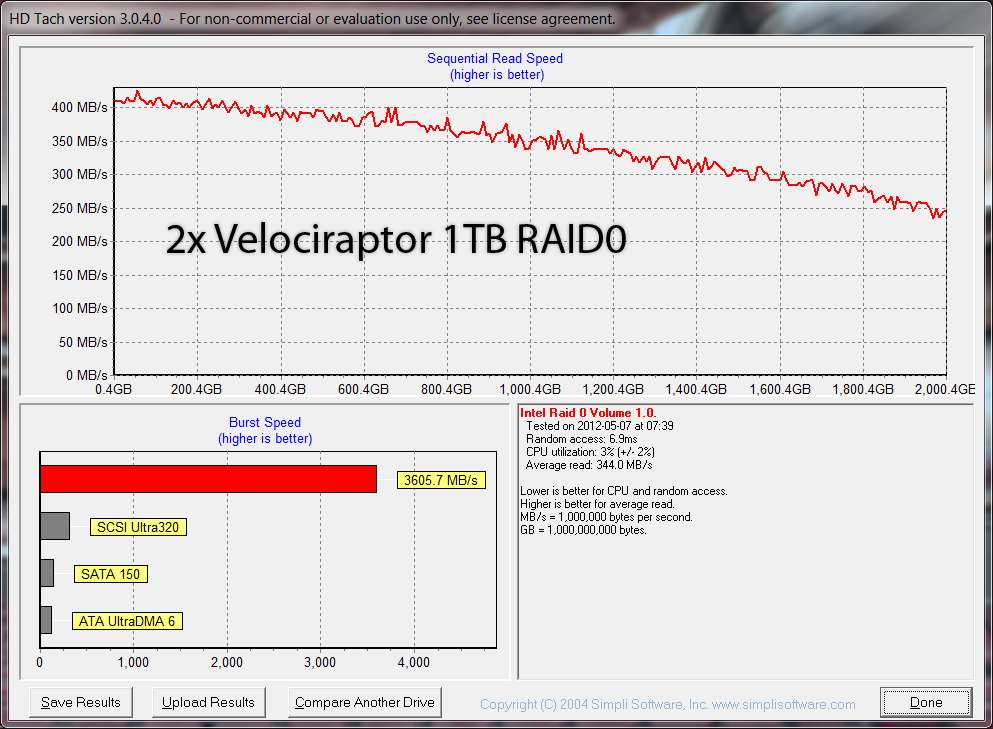
Media Drive U - Partition 1 of 640GB WD Caviar Black in RAID1: Music, Photos, Creative Content, etc.
Archives Drive V - Partition 2 of 640GB WD Caviar Black in RAID1: Backup of Executables, Disk Images, and Creative Content.
USB Drive W - 160GB USB 2.0 IOmega Drive: Redundancy Backup
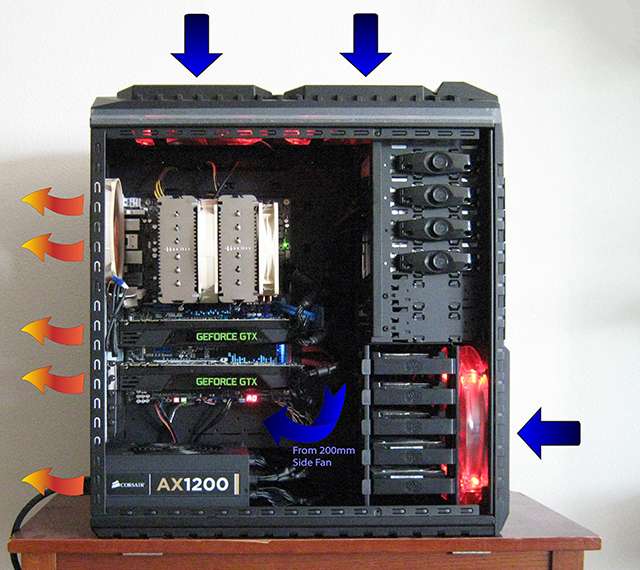
Not a big fan of dust. To keep dust out, I maintain positive pressure in my case by flipping the top fans to intake. Of course, if all fans are intake, the incoming air needs to be filtered too. I used DEMCiflex filters specially made for my HAF-X case. They are fine as silk and keep all but the smallest particle of dust outside the case. Maintenance of dust only requires me to vacuum the external dust filters once a month.
All the 200mm intakes have 7V resistors on them to further minimize the acoustic footprint.


The PC in its natural habitat. The elevated position of the PC further reduces the amount of dust reaching it.
An Asus 120hz 27" VG278H monitor coupled with an HP 60hz 21" 2159m side panel makes for excellent gaming as well as everyday desktop usage.
Note the combination of cherry brown mechanical keyboard, the Razer Orochi mouse on a slick Ratpadz makes simple tasks like moving the mouse around typing a complete joy to perform.
There isn't a single thing in my PC that's left more to desire... Granted, it's powerful, but it's not the most powerful I can get; it's a powerful compromise between power, temperature, and acoustics, and with those consideration, I literally got everything I wanted in my PC to the letter. I'm just going to sit pretty on top of this upgrade and enjoy it for years to come. Some stats and benches of my PC:
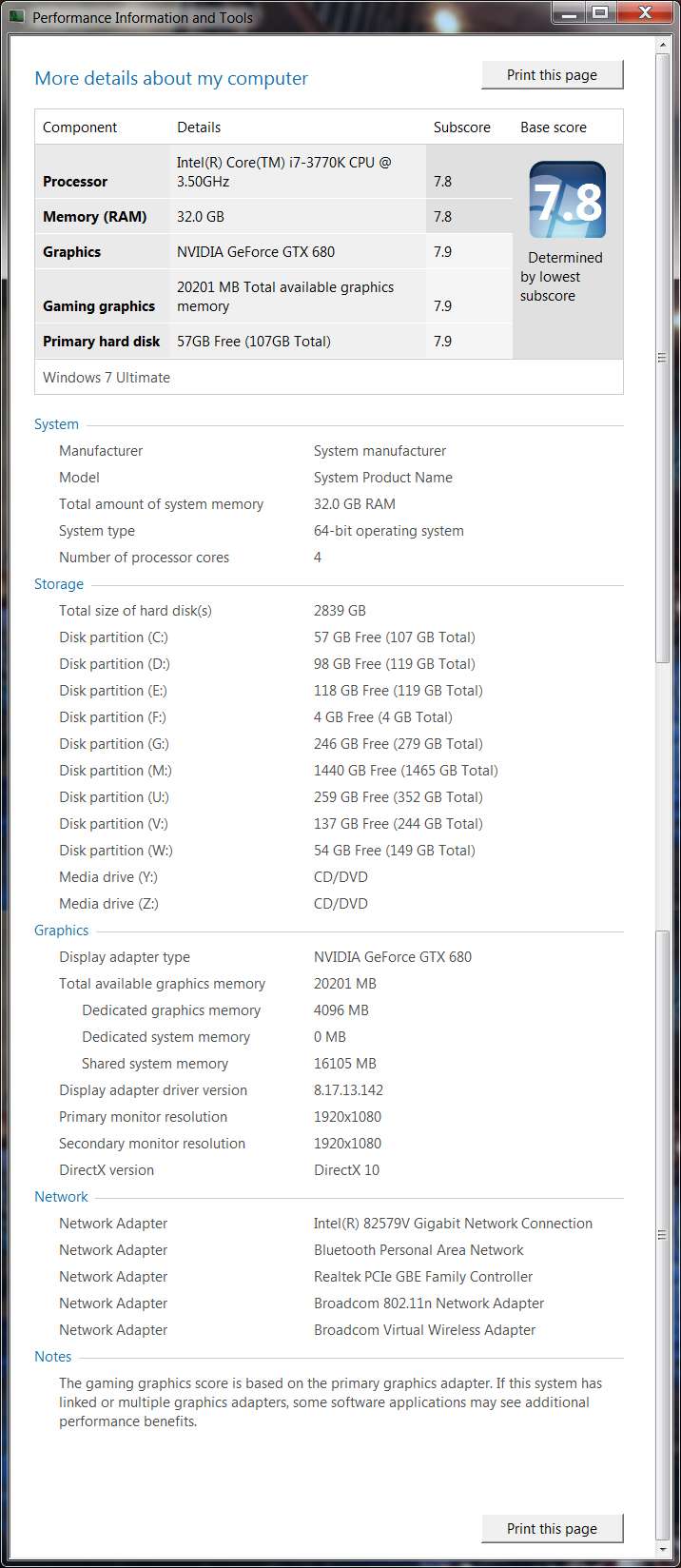
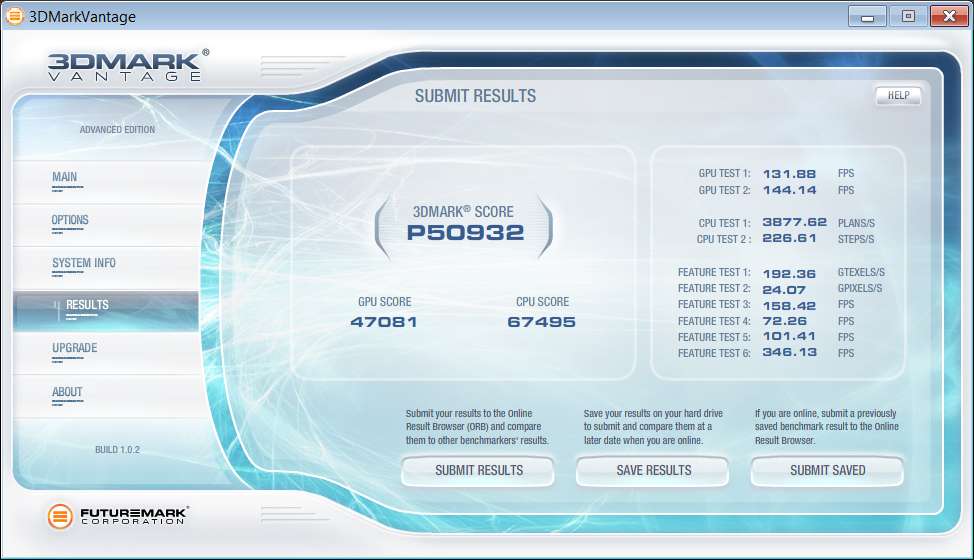
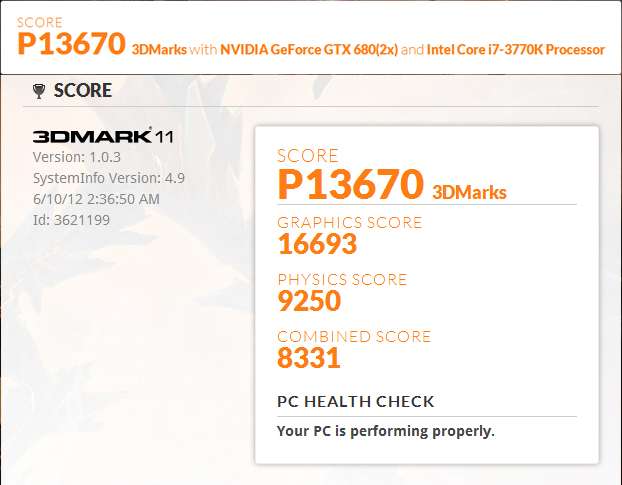
CPU: Core i7 3770k @ 4.2-GHz
CPU Heatsink: Noctua NH-D14
MOBO: Asus P8Z77-V Deluxe
GPU: 2x Zotac GTX 680 4GB in SLI
RAM: 32GB G-Skill Ares 1600 RAM
SSD: 1x Crucial M4 128GB, 2x Samsung 830 128GB (non-RAID)
HDD: 1x WD Velociraptor 300GB, 2x WD Velociraptor 1-TB RAID0, 2x WD 640GB Black RAID1
PSU: Corsair AX1200 PSU
CASE: Cooler Master HAF-X
MONITOR Asus VG278H 120hz Monitor, HP 2159m Side Panel- Show previous comments 35 more
-
 Creaphis said:
Creaphis said:Well, "doing something about Doom" can also mean recording demos, or writing reviews, or, in my case, idly pondering matters of game design. None of these require much processing power. I would upgrade without hesitation if I actually needed to for some creative pursuit, like mapping, programming or composition, but I haven't been doing any of that stuff lately. There is definitely a part of my psyche, though, that feels I should be doing that kind of stuff, and the carrot on a stick that it's dangling in front of the rest of my brain is a hardware upgrade. "Start making Doom maps..." it whispers, "there's a new computer in it for you if you do..."
Aside from making Doom maps, a powerful computer is one of the worst enablers I could have possibly came across.
"Make bigger Doom maps..."
"There's already a new computer in front of you... It won't crash..."
"Start making HD content..."
"There's already a new computer in front of you... It won't slow you down..."
"Start playing these cool-looking games..."
"There's already a new computer in front of you... What are you waiting for?"
"Look at the UE4 Engine..."
"You already have the power to run it... You should try your hands at it..." -
Impressive. Does it work perfectly at whisper-quiet sounds? My experiences with computer cases is less than ideal, with loud grating noises coming from the fans after long enough, and dust piling up. How do you figure what kind of power supply you'll need? Can you tell how many watts the computer will require?
-

Of course it works perfectly. It's quiet because large fans moves larger volume of air with lesser rotational frequency.
You can use a power supply calculator like this one for a good estimate of how big of a supply you're gonna need. I personally always add a few hundred watts more than my calculated need for reasons of unforeseen hardware addition, and decrease in PSU efficiency over time.
For real world measurement of power usage, I have a Kill-A-Watt device. The highest I've seen drawn from my PC, is 475 Watts at the wall, when I'm stress testing it.
-
Having played modern shooters like Doom 3, Quake 4, FEAR, and HL2, those will be the shooters that I will be measuring Crysis against.
Also known as That One Game to bring systems down to their knees, Crysis has often been labeled as more of a "tech demo" than a real game by the general public. The minimal system requirements of Crysis is quite high and optimal settings even higher. What if the staggering system requirements were a non-issue? One can finally play the game in its full potential. I recently upgraded my PC to the point where I'm able to keep a steady frame in Crysis on the highest settings, to play it as it was meant by the creators.
Crysis, more than the others, is heavily reliant on visuals to immerse the player in its vast environment. From the lush tropical beach jungles to the way "God rays" shine through the foliage, it is a VERY pretty game no doubt. Sometimes I'd have to idle and just take a deep look at the way vegetation and landscape goes off miles into the vista, like a photograph off a vacation magazine.
First person shooters on the PC have evolved to the point where if the developers didn't fuck it up, it'll play great. WASD. The control schemes of Crysis is complex but intuitive, the lean left-right movement emphasizes the precision of combat; some games have it, some don't, having it allows you to peek-a-boo around the corner is always a big plus in my eyes. The player's nanosuit add new depths to the ways you can approach an objective. I could either cloak my way past the guards, confront them in a balls-out firefight, or just ignore them as I "superspeed" towards my goal. The layout of the enviroment encourages multiple routes to completing the same objective, which adds extra non-linearity to gameplay.
I've heard accounts of fucked up AI behavior, but haven't encountered much of it myself playing on "Normal" and even when the AI messes up at times, like idling when their nearby buddies are sniped, it's not a deal-breaker. On the contrary, the AI is good most of the time, they are able to work in teams beelining my position when I sniped one of their buddies from afar, or check out suspicious movement when I'm cloaked and moving.
As for environment interaction, almost every trees and shacks are destructible and can be smashed to smithereens. I was able to pick up any items and toss it at enemies (who needs the gravity gun when your nanosuit is at maximum strength), take apart sentry towers with missiles, deforest combat zones, and overall just carve a trail of havoc everywhere I went.
Gameplay is more open sandbox than HL2, with higher combat complexity than FEAR. It's loose enough to let the player wander off and explore, but still has progression as the objective dictates.
The storyline is the typical ancient-weapon-alien-discovery explosion hypercombo, the theme of the story itself I didn't care for, what's more important is how it was told. The storyteling fidelity is somewhere between HL2 and Quake 4. Like HL2, the story unfolds 1st person through the player's eyes as the game progresses, and can be very epic at times, a notable instance is in the middle of an armored assault, you suddenly see the mile-high mountain in front of you literally crack away to reveal a spaceship. Right in front of your eyes is the emphasis here, no matter how epic.
Crysis, when on an adequately powered system, is an excellent game. It's not only pretty, but well made, nonlinear with a deep combat system, and just plain fun to play. I'm going to play it again sometimes after I finish Warhead, it's that good.- Show previous comments 3 more
-

-

-

It's beautiful, it's wide open, but I felt it only plays average. It's fun to bash up huts in strength mode at first. It's fun to clown around, and generally blow stuff up, but it didn't last. I do have the hardware to run it acceptably at high settings, but I've enjoyed newer games with lower system requirements more. If you can run it and find it relatively cheap, it's worth it though.
-
Tired of Doom Builder 2 sledging my laptop to a crawl (65k segs being saved into a 270 MB wad will clog a 5400 RPM drive), I decided to upgrade into something that will run Photoshop, Illustrator, Doom Builder 2, and a gazillion FireFoxes at the same time with Winamp on, to increase my mapping efficiency... that and uh... I'd like to romp Crysis with maxed out settings... heh



Those fans are totally justified in the next screen...

Because overclocking generates serious heat.
Built with 45nm processes, the i7 920 requires less voltage than their 55nm Core 2 predecessors, which translates to less power consumption, less heat, and ultimately, better overclocking potential.
My i7 920 was gotten for $250 shipped. I did a little research and tried my hand at OC'ing for once. Got it rock stable at 3.8 GHz, any higher would result in Vista not posting. At this speed, it outperformed even Intel's own $1000 flagship processor...

Intel Core i7 920 Overclocking
...As the benchmark results show, there was quite a large performance delta that separated the stock Core i7 920 and the 965 Extreme. In every single test, the Core i7 965 Extreme outperformed the stock Core i7 920 by a sizable margin. With our Core i7 920 processor overclocked from 2.66GHz to 3.8GHz, however, the tables were completely turned. Our modded and overclocked system outpaced the Core i7 965 Extreme by margins ranging from 4.66% to as high at 15.63%...Notes:
*With the Hyper Threading feature turned on, each of the i7's four cores can process two threads at once, showing up as 8 cores on Vista's CPU monitor.
*11 fans running keeps the overclocked core idle at 40c and 60c load.
*Stock voltage for the i7 920 @ 2.66 GHz is reported to be about 1.1-1.2V. My 3.8 GHz OC is stable at 1.25V. Easiest GHz gain ever.
*Multi-GPU scaling for the dual HD 4890s in Crossfire mode @1080p produces a 193% increase in performance versus a single card. Near perfect performance scaling...

*The Half-Life 2: Lost Coast stress test with everything maxed out with 4xAA on 1080p resolution reported 212 fps avg.
... HAR HAR, MAH E-PEEN IS BIGGAR THAN YERS =P


















